Filey Dams is a Yorkshire Wildlife Trust reserve leased from Scarborough Borough Council and is managed in partnership with Filey Bird Observatory & Group (FBOG), who record the species of the area and carry out routine maintenance.
Overview: Saved from the developer’s bulldozer in 1985 the reserve nestles on the western edge of Filey town and is the last remaining freshwater marsh of any size in the area. Although primarily of ornithological interest, the Dams also has an impressive botanical diversity, and is home to an array of small mammals and amphibians. At a little over six hectares, it’s an area to enjoy in situ rather than wander across – easily done, with two purpose-built hides offering uninterrupted views of the whole reserve.
A checklist of birds recorded at the Dams appears at the foot of this page.
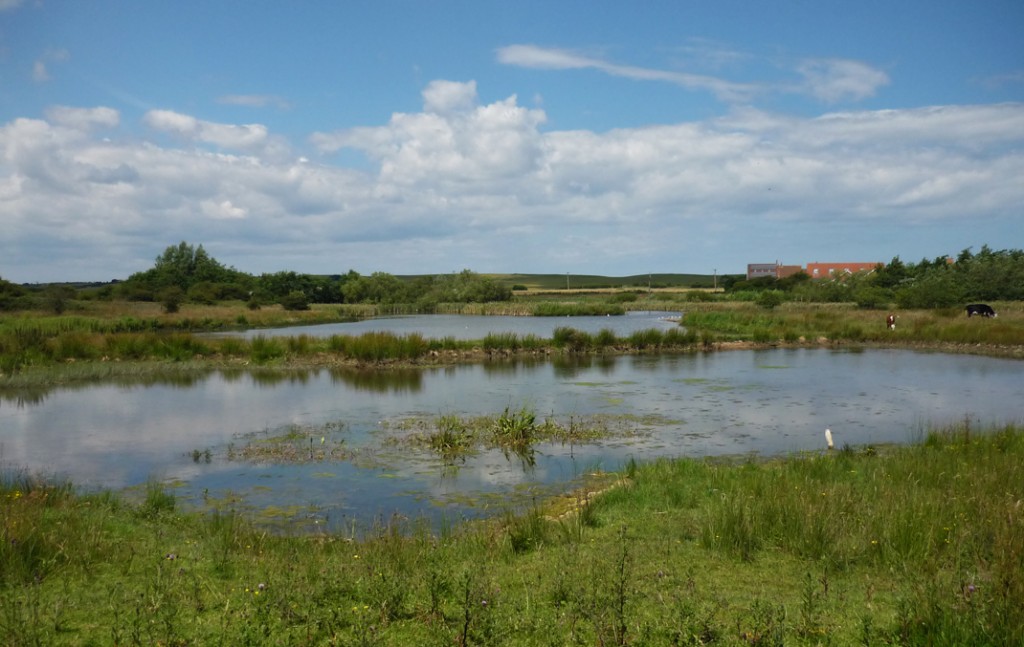
The detail: The open water and its fringes attract a wide range of aquatic and semi-aquatic species, and the reserve is especially important for migrating birds, which use the Dams as a vital pit-stop on their way to often far-flung breeding or wintering grounds. Ducks, geese, swans, waders, herons and various other birds all frequent the reserve, and every year brings new surprises and rarities.
The area surrounding the ponds is neutral grassland, most of which is grazed by cattle. The fenced areas are a sanctuary for ground-nesting birds and provide tall grasses for insects. Soft Rush dominates, joined in the shallow water by Toad Rush, Bottle Sedge and Branched Bur-reed. Other species include Large Bittercress, Water Plantain and Flag Iris. Smooth, Palmate and Great Crested Newt are sometimes seen by day (but usually by torchlight), the latter species in nationally important numbers.
A short walk from the car park and adjacent Main Hide takes in a small copse with nest boxes (provided for our healthy Tree Sparrow population), and leads along a boardwalk to a pond-dipping platform at the edge of a quiet pool. Here dragonflies skim the water settling on the mat of Amphibious Bistort; the fortunate might see Water Vole, but are more likely to hear them crunching their way through the soft stalks of Water Forget-me-not.
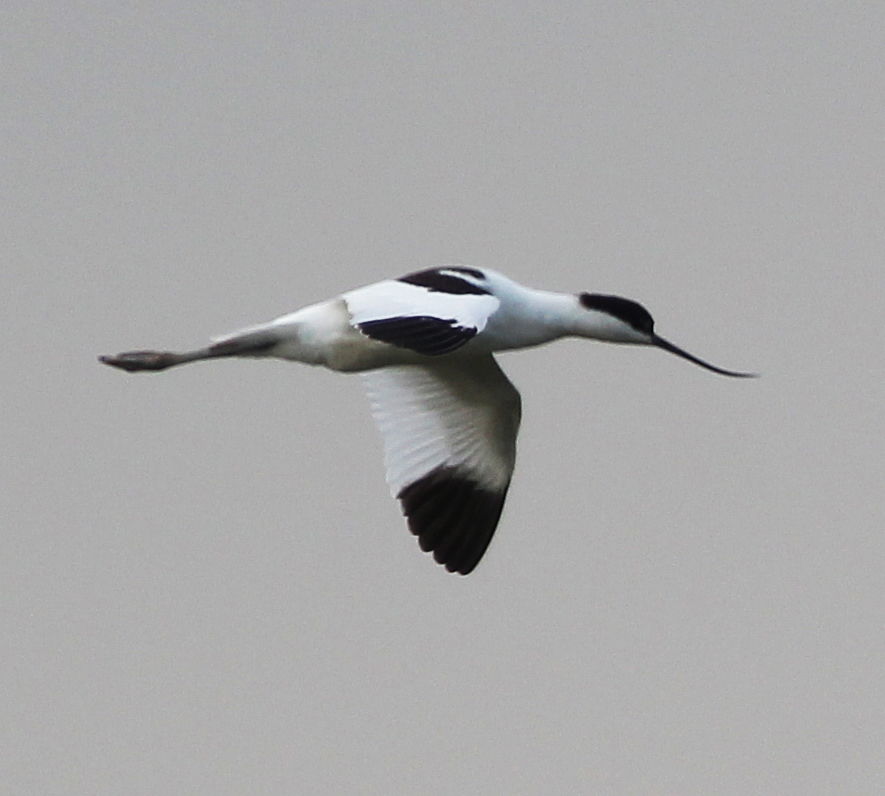
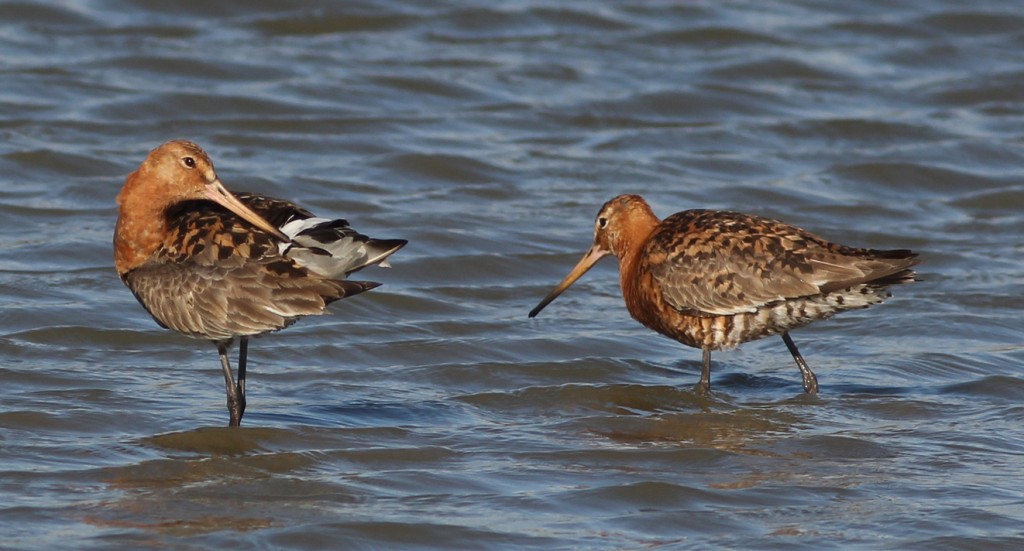
Black-tailed Godwits in August (Mark Pearson)
Walk further along the boardwalk and arrive at the East Pool Hide, where close views can be had of waterbirds including Little Grebe and Tufted Duck and waders such as Greenshank, Common Snipe and Wood Sandpiper in the autumn. Across the pool, the Barn Owl box will hopefully be occupied, the male often outposted in nearby cover when displaced by his family.
Occasional public bird-watching and small-mammal trapping sessions are held – check the News page for details – and local school children visit to pond-dip, learn about wildlife and watch bird-ringing.
Seasonal highlights:
Spring (March – May): Waders stop by on migration, there’s a good chance of a fox from the hides, the nest boxes are full of Tree Sparrows, Willow Warblers sing and Cuckoo Flower starts to colour the marsh.
Summer (June – August): Reed Warblers sing from the reed-beds, watched by Cuckoos, while on the muddy edges of the pool the first returning sandpipers and plovers feed. Dragonflies such as Broad-bodied Chaser, Black-tailed Skimmer and Ruddy Darter are active over the pools.
Autumn (September – November): Greenshank, Little Stint, Curlew Sandpiper and Ruff pause to feed up on their way south (as well as commoner waders). Hirundines gather in increasingly large parties, occasionally attended by a Hobby.
Winter (December – February): The pools are home to Wigeon and Teal flocks, other duck species and various geese. Sparrowhawks sit in the bleak hawthorn trees watching the feeding tables where sparrows, thrushes and finches gather in good numbers.
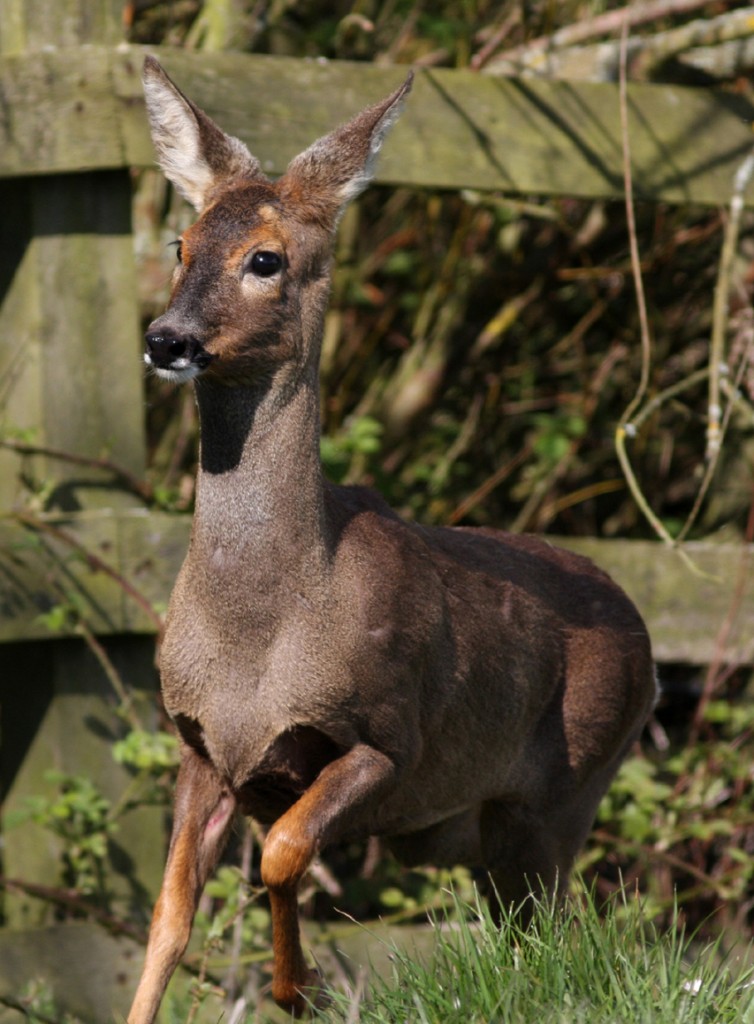
Top tips: Waders in autumn and ducks in winter are available all day; try a dawn or dusk trip for Roe Deer, Fox or hunting Barn Owl. Attend a mammal-trapping session and get close to Wood Mouse, Bank Vole and Water Shrew.
Access & Directions: There is Wheelchair access to the Main Hide, which is a few metres from the reserve car park. The hides are always open. Dogs are not allowed on the reserve. There are no toilets or other facilities on site, the nearest being in Filey town.
Public transport: Scarborough – Hull buses and trains call at the nearby Filey bus and train stations.
Directions: The reserve car park is at the end of Wharfedale, a left turn entering Filey on Muston Road from York and Bridlington, 450 metres before the railway crossing. If arriving from Filey bus and train stations, it’s a fifteen-minute walk: cross the level crossing on Muston Road, take your second right onto Wharfedale and follow it to the end.
Filey Dams Facebook Group Page
Contact: info@ywt.org.uk / 01904 659570
Grid reference: TA 106807
Nearest postcode: YO14 0DG
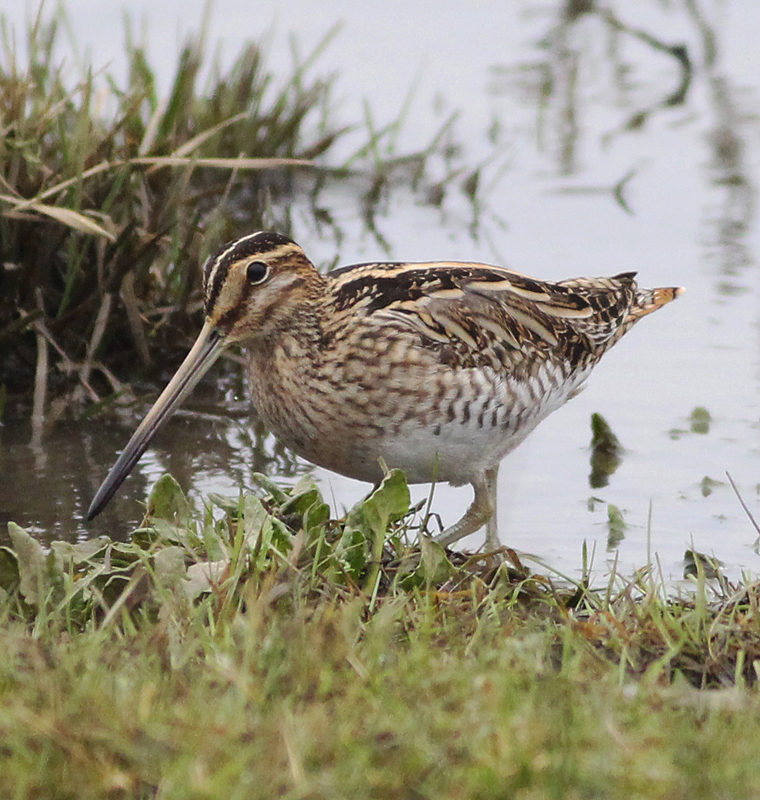
Checklist of the birds of the Dams
A full species list giving the status of all visitors to the reserve is given below.
Red-legged Partridge Electors ruff. Very scarce, not recorded recently.
Grey Partridge Perdix perdix. Occasional, heard singing in Spring. Breeds nearby.
Quail Coturnix coturnix. Rare; only heard singing.
Pheasant Phasianus colchicum. Ubiquitous; breeds.
Bean Goose Anser fables. Scarce: both subspecies have been recorded.
Pink-footed Goose Anser brachyrhynchus. Winter visitor in small numbers.
Greylag Goose Anser anser. Regular feral visitor.
White-fronted Goose Anser albifrons. Winter visitor in varying numbers (never common); all Scandinavian.
Snow Goose Anser caerulescens. One record: 2005
Canada Goose Branta kanalens. Regular feral visitor; breeds.
Brent Goose Branta bernicla. Rare visitor.
Barnacle Goose Branta leucosis. Regular feral visitor in small numbers.
Mute Swan Cygnus olor. Breeder, fairly common.
Bewick’s Swan Cygnus columbines. Rare visitor.
Whooper Swan Cygnus Cygnus. Scarce winter visitor.
Egyptian Goose Alopochen aegyptiaca. Very scarce visitor.
Common Shelduck Cadorna tadorna. Fairly common in small numbers.
Ruddy Shelduck Cadorna ferruginea. Rare visitor.
Mandarin Duck Aix galericulata. Annual visitor, increasing.
Gadwall Anas striper. Fairly common in small numbers.
Eurasian Wigeon Anas Penelope. Common autumn/winter visitor.
Mallard Anas platyrhynchos. Common breeder.
Blue-winged Teal Anas discord. One record, a male in 2006.
Shoveler Anas clypeata. Fairly common in small numbers.
Pintail Anas acuta. Scarce.
Garganey Anas querquedula. Very scarce summer visitor.
Teal Anas crecca. Common.
Green-winged Teal Anas carolinensis. One record, a male in 2005.
Red-crested Pochard Netta ruffian. Two records: three in 1991 and a male in 2013.
Pochard Aythya ferina. Increasingly scarce, has bred.
Tufted Duck Aythya fuligula. Common visitor, breeder.
Scaup Aythya marina. Rare.
Eider Somateria mollissima. One record, a male in 2008.
Long-tailed Duck Clangula hyemalis. Scarce.
Goldeneye Bucephala clangula. Occasional visitor.
Smew Mergellus albellus. Rare.
Goosander Mergus merganser. Scarce visitor.
Red-breasted Merganser Mergus serrator. Rare.
Ruddy Duck Oxyura jamaicensis. Has bred, now locally extinct.
Red-throated Diver Gavia stellate. Rare.
Fulmar Fulmarus glacialis.One record, a sick bird in 1996.
Little Grebe Tachybaptus ruficollis. Fairly common breeder.
Red-necked Grebe Podiceps grisegena. Rare.
Slavonian Grebe Podiceps auritus. One record: 2013
Black-necked Grebe Podiceps nigricollis
Rare: 1987, 2002.
White Stork Ciconia ciconia. One record: 1998.
Glossy Ibis Plegadis falcinellus. One record: 2011.
Spoonbill Platalea leucorodia. Scarce.
Bittern Botaurus stellaris. Four records: 1988, 1991, 1999, 2003.
Grey Heron Ardea cinerea. Common.
Purple Heron Ardea purpurea. Two records: 1987, 1994.
Great White Egret Ardea alba. One record: 2013
Little Egret Egret garzetta. Annual, increasing.
Gannet Morus bassanus. Occasional, on the horizon.
Cormorant Phalacrocorax carbo. Regular.
Kestrel Falco tinnunculus. Scarce.
Merlin Falco columbarius. Rare.
Hobby Falco subbuteo. Scarce.
Peregrine Falcon Falco peregrinus. Scarce.
Osprey Pandion haliaetus. Scarce.
European Honey Buzzard Pernis apivorus. Rare.
Red Kite Milvus milvus. Rare.
Marsh Harrier Circus aeruginosus. Scarce.
Hen Harrier Circus cyaneus. Rare.
Montagu’s Harrier Circus pygargus. Rare.
Sparrowhawk Accipiter nisus. Common, local breeder.
Buzzard Buteo buteo. Scarce.
Rough-legged Buzzard Buteo lagopus. Rare.
Water Rail Rallus aquaticus. Regular but elusive, has bred.
Spotted Crake Porzana porzana. Three records: 1999, 2001, 2003.
Moorhen Gallinula chloropus. Common breeder.
Coot Fulica atra. Common breeder.
Crane Grus grus. Rare.
Oystercatcher Haematopus ostralegus. Common.
Black-winged Stilt Himantopus himantopus. One record: 1991.
Avocet Recurvirostra avosetta. Scarce.
Lapwing Vanellus vanellus.Uncommon.
Golden Plover Pluvialis apricaria. Scarce.
Grey Plover Pluvialis squatarola. Scarce.
Ringed Plover Charadrius hiaticula. Uncommon.
Little Ringed Plover Charadrius dubious. Regular in small numbers.
Dotterel Charadrius morinellus. Vagrant – a small trip in 1982.
Woodcock Scolopax rusticola. Regular but elusive.
Jack Snipe Lymnocryptes minimus. Regular but elusive.
Common Snipe Galling gallinago.Fairly common.
Black-tailed Godwit Limosa limosa. Fairly common.
Bar-tailed Godwit Limosa lapponica. Scarce.
Whimbrel Numinous phaeopus. Uncommon.
Curlew Numinous arquata. Common.
Spotted Redshank Tringa erythropus. Scarce.
Redshank Tringa tetanus. Common.
Greenshank Tringa nebularia. Uncommon.
Lesser Yellowlegs Tringa flavipes. Three records: 1986, 2000, 2005.
Green Sandpiper Tringa ochropus. Uncommon.
Wood Sandpiper Tringa glareola. Uncommon.
Common Sandpiper Actitis hypoleucos. Fairly common.
Turnstone Arenaria interpres. Scarce.
Little Stint Calidris minuta. Scarce.
Temminck’s Stint Calidris temmminckii. Rare.
White-rumped Sandpiper Calidris fuscicollis. Two records: 2006, 2012.
Baird’s Sandpiper Calidris bairdii. One record: 1995.
Pectoral Sandpiper Calidris melanomas. Scarce.
Curlew Sandpiper Calidris ferruginea. Scarce but regular.
Dunlin Calidris alpine. Common
Ruff Philomachus pugnax. Uncommon.
Red-necked Phalarope Phalarope lobatus. Two records: 2001, 2004.
Common Gull Larus canus. Common.
Great Black-backed Gull Larus marinus. Common.
Glaucous Gull Larus hyperboreus. Rare.
Iceland Gull Larus glaucoides. Rare.
Herring Gull Larus argentatus. Common.
Yellow-legged Gull Larus michahellis Two records: 1996, 2006.
Lesser Black-backed Gull Larus fuscus. Uncommon.
Black-headed Gull Larus ridibundus. Common.
Mediterranean Gull Larus melanocephalus. Scarce.
Little Gull Larus minutus. Scarce.
Kittiwake Rissa tridactyla. Rare.
Sandwich Tern Sterna sandvicensis. Rare.
Common Tern Sterna hirundo. Rare.
Arctic Tern Sterna paradisaea. Rare.
White-winged Black Tern Chlidonias leucopterus. One record: 1999.
Black Tern Chlidonias niger. Rare.
Great Skua Stercorarius skua. Rare.
Arctic Skua Stercorarius parasiticus. Rare.
Long-tailed Skua Stercorarius longicaudus. One record: 2006.
Rock Dove Columba livia. Feral, common.
Stock Dove Columba oenas. Uncommon.
Woodpigeon Columba palumbus. Common.
Turtle Dove Streptopelia turtur. Rare.
Collared Dove Streptopelia decaocto. Common.
Cuckoo Cumulus canorus.Scarce. Breeds.
Barn Owl Tyto alba. Breeds in the nest box.
Tawny Owl Strix aluco. Often heard, rarely seen.
Little Owl Athene noctua. Rare.
Long-eared Owl Asio otus. Rare.
Short-eared Owl Asio flammeus. Scarce.
Nightjar Caprimulgus europaeus. One record: at roost in 1997.
Alpine Swift Tachymarptis melba. One record: 1994.
Swift Apus apus. Common.
Kingfisher Albedo atthis.Scarce.
Hoopoe Upupa epops. Two records: 1994, 1995.
Wryneck Jynx torquilla. One record: 2002.
Great Spotted Woodpecker Dendrocopos major. Common, breeds.
Green Woodpecker Picus viridis. Rare.
Red-backed Shrike Lanius collurio. Rare.
Great Grey Shrike Lanius excubitor.. Rare.
Golden Oriole Oriolus oriolus. Rare.
Jay Garrulous glandarius. Scarce.
Magpie Pica pica. Common, breeds.
Jackdaw Corvus monedula. Common, breeds.
Rook Corvus frugilegus. Common, breeds.
Carrion Crow Corvus corone. Common.
Hooded Crow Corvus cornix. Rare.
Waxwing Bombycilla garrulous. Scarce.
Great Tit Parus major. Common, breeds.
Blue Tit Parus caeruleus. Common, breeds.
Coal Tit Parus ater. Scarce.
Marsh Tit Parus palustris. One record: 1999.
Willow Tit Parus montanus. Scarce.
Sand Martin Riparia riparia. Common.
Swallow Hirundo rustica. Common.
House Martin Delichon urbica. Common.
Red-rumped Swallow Cecropis daurica. One record: 2004.
Long-tailed Tit Aegithalos caudatus. Common, breeds.
Skylark Alauda arvensis. Common.
Grasshopper Warbler Locustella naevia. Rare.
Sedge Warbler Acrocephalus schoenobaenus. Common, breeds.
Reed Warbler Acrocephalus scirpaceus. Common, breeds.
Marsh Warbler Acrocephalus palustris. One record: 1994.
Icterine Warbler Hippolais icterina. One record: 1995.
Willow Warbler Phylloscopus trochilus. Common, breeds.
Chiffchaff Phylloscopus collybita. Common, breeds.
Siberian Chiffchaff Phylloscopus tristis. One record: 2008.
Wood Warbler Phylloscopus sibilatrix. Rare.
Pallas’s Warbler Phylloscopus proregulus. One record: 2004.
Yellow-browed Warbler Phylloscopus inornatus. Scarce.
Arctic Warbler Phylloscopus borealis. One record: 1993.
Blackcap Sylvia atricapilla. Common, breeds.
Garden Warbler Sylvia borin. Scarce.
Barred Warbler Sylvia nisoria. Two records: 1994, 2001.
Lesser Whitethroat Sylvia curruca. Common, breeds.
Whitethroat Sylvia communis. Common, breeds.
Treecreeper Certhia familiaris. Scarce.
Starling Sterns vulgaris.Common, breeds.
Ring Ouzel Turdus torquatus. Scarce.
Blackbird Turdus merula. Common, breeds.
Fieldfare Turdus pilaris. Common.
Redwing Turdus iliacus. Common.
Song Thrush Turdus philomelos. Fairly common, breeds.
Mistle Thrush Turdus viscivorus. Uncommon.
Robin Erithacus rubecula. Common, breeds.
Bluethroat Luscinia svecica. Two records:1993, 1994
Black Redstart Phoenicurus ochruros. Rare.
Redstart Phoenicurus phoenicurus. Scarce.
Whinchat Saxicola rubetra. Scarce.
Stonechat Saxicola torquatus. Rare.
Wheatear Oenanthe oenanthe. Scarce.
Spotted Flycatcher Muscicapa striata. Scarce.
Pied Flycatcher Ficedula hypoleuca. Uncommon.
Red-breasted Flycatcher Ficedula parva. Rare.
House Sparrow Passer domesticus. Common, breeds.
Tree Sparrow Passer montanus. Common, breeds.
Dunnock Prunella modularis. Common, breeds.
Yellow Wagtail Motacilla flava. Regular
Citrine Wagtail Motacilla citreola. One record: 1995.
Grey Wagtail Motacilla cinerea. Uncommon.
Pied Wagtail Motacilla alba. Common, breeds. White Wagtail is scarce.
Meadow Pipit Anthus pratensis. Common.
Tree Pipit Anthus trivialis. Scarce.
Olive-backed Pipit Anthus hodgsoni. One record: 1987.
Water Pipit Anthus spinoletta. Three records: 1987, 1994, 2002.
Rock Pipit Anthus petrosus. Rare.
Chaffinch Fringilla coelebs. Common, breeds.
Brambling Fringilla montifringilla. Regular in small numbers.
Greenfinch Carduelis chloris. Common.
Siskin Carduelis spinus. Fairly common.
Goldfinch Carduelis carduelis. Common.
Lesser Redpoll Carduelis cabaret. Uncommon.
Mealy Redpoll Carduelis flammea. Uncommon.
Linnet Acanthis cannabin. Common.
Common Rosefinch Carpodacus erythrinus. Two records: 1995, 1997.
Crossbill Loxia curvirostral. Scarce.
Bullfinch Pyrrhula pyrrhula. Uncommon.
Corn Bunting Emberiza calandra. Rare.
Yellowhammer Emberiza citronella. Uncommon.
Ortolan Bunting Emberiza hortulana. One record: 1994.
Rustic Bunting Emberiza rustic. Four records: 1985, 1989, 1990, 1993.
Reed Bunting Emberiza schoeniclus. Common, breeds.
Snow Bunting Plectrophenax nivalis. Rare.

